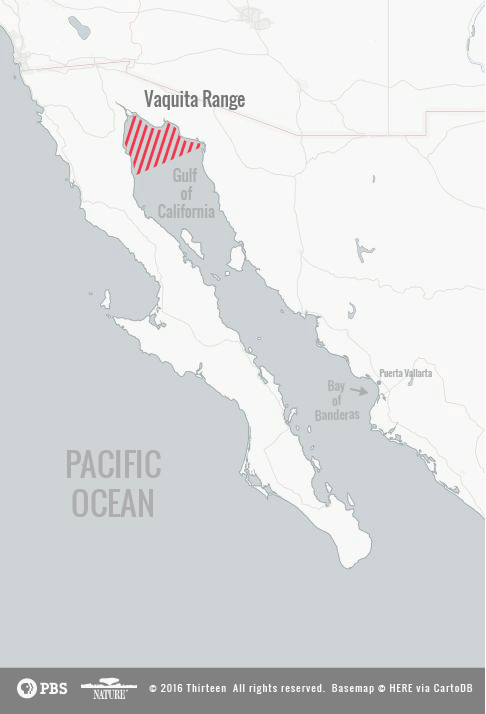
A model vaquita (Phocoena sinus) wrapped in a net. | Credit: Greenpeace
The vaquita (pronounced VA-Keeta) is the smallest, and most endangered, whale species in the world. It reaches a maximum length of 5 feet and weighs less than 120 lbs. Vaquitas are easily distinguished by the dark markings around their lips and eyes, which look a bit like dark lipstick and mascara. The name vaquita means “little cow” in Spanish.

The diminutive porpoise thrives in murky coastal waters where it uses echolocation to hunt schooling fish, crustaceans, squid, and octopus. Unlike more gregarious cetaceans, such as the bottlenose dolphin, the vaquita is a shy and solitary animal. It avoids boats and is typically seen alone or in pairs. It’s so reclusive, the little whale wasn’t known to science until 1958 and then only based on several skulls that had washed ashore.

A rare vaquita sighting in the Gulf of California. | Paula Olson, NOAA
The vaquita is only found one place in the world, the northern end of the Gulf of California, the long stretch of ocean between mainland Mexico and the Baja peninsula. Its range may have once extended much farther south, all the way to the Bay of Banderas, near modern-day Puerto Vallarta. Scientists think the vaquita may be an offshoot of the South American Burmeister’s porpoise that became geographically separated long ago. Similar in size and behavior, but lacking the dark facial markings, the Burmeister’s is ubiquitous along South America’s coastlines.

Today, the vaquita has the unfortunate distinction of being the world’s most endangered cetacean. Gillnet fishing, which started in the 1940s, has caused a precipitous decline in the population. Gillnets are long vertically-hanging nets that ensnare any fish or sea life that come in contact. Scientists estimate up to 80 vaquita are drowned each year by gillnets and warn that if the trend continues, the species will go extinct by the year 2018.

Responding to pressure from the scientific community, the Mexican government declared the far north end of the Gulf a bioreserve in 1993 and banned all gillnet fishing. In 2005, it extended protection southward, creating a gillnet-free vaquita refuge. However, enforcement in these protected areas has been minimal. Satellite photos have routinely revealed gillnet boats, called pangas, within the refuge. In 2015, Mexican president Enrique Peña Nieto declared a two-year ban on gillnets over 1200 square miles of vaquita territory. He also enlisted the Mexican navy to enforce the ban and armed them with new high-speed boats, drones and light aircraft.

The government has also enacted an unprecedented $30 million buy out scheme, essentially paying local fisherman not to fish. This strategy has removed roughly 800 fishing boats from the Gulf. However, a powerful new financial incentive is undermining these efforts. In the last several years, Chinese demand for the swim bladder of the totoaba (Totoaba macdonaldi), a giant sea bass that shares the vaquita’s range, has increased substantially. Chinese chefs use the bladder in a dish called fish maw soup, which is believe to have medicinal value. A single bladder can fetch thousands of dollars on the black market and the lure of easy money has led some local fishermen to ignore the gillnetting ban. They set large anchored nets for the totoaba at night when it is more difficult for law enforcement to track their movements.

A totoaba swim bladder seized by the U.S. Fish and Wildlife Service | Credit: USFWS
Sources:
Vaquita. NOAA Fisheries. Accessed June 24, 2016: http://www.fisheries.noaa.gov/pr/species/mammals/porpoises/vaquita.html
Demand for Fish Bladder May Wipe Out World’s Rarest Ocean Mammal. National Geographic News. http://news.nationalgeographic.com/2016/01/160111-vaquita-totoaba-poaching-swim-bladders/
Mexico’s new plan to save rare vaquita porpoise. San Diego Tribune. http://www.sandiegouniontribune.com/news/2015/apr/16/endangered-vaquita-plan-save-gulf-california/
Briefing to the 66th Standing Committee of CITES. Environmental Investigation Agency. https://eia-international.org/wp-content/uploads/EIA-Dual-Extinction.pdf
Vaquita gillnet ban begins. Marine Mammal Center. https://www.marinemammalscience.org/smm-news/vaquita-gillnet-ban-begins-april-29-2015/
Report of the Fifth Meeting of the Comité Internacional para la Recuperación de la Vaquita (CIRVA-5) http://assets.worldwildlife.org/publications/713/files/original/2014_Vaquita_Report_Fifth_Meeting_of_CIRVA.pdf?1408479198
Vaquita Fact Sheet. NOAA Southwest Fisheries Science Center. https://swfsc.noaa.gov/uploadedFiles/VaquitaFactSheet.Version3a.pdf
Encyclopedia of Marine Mammals. http://bit.ly/28R3m2V
